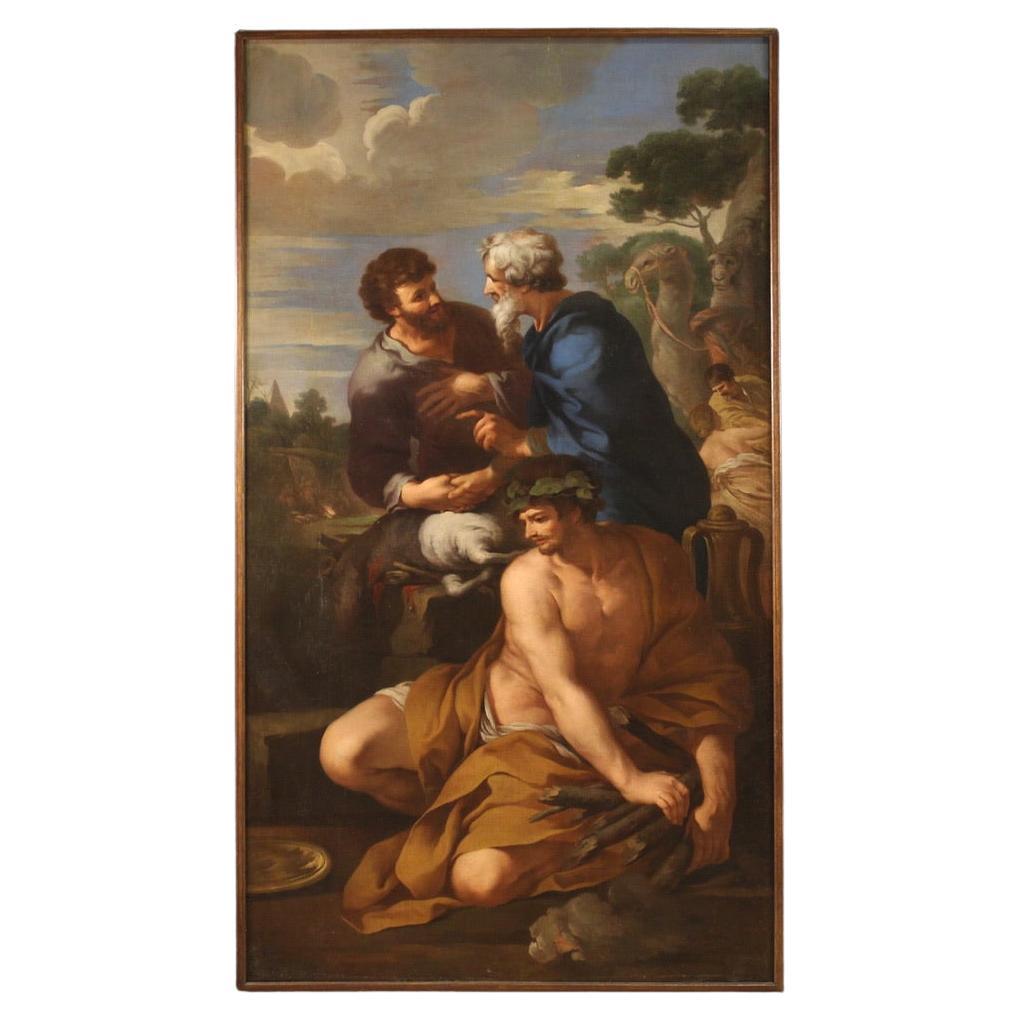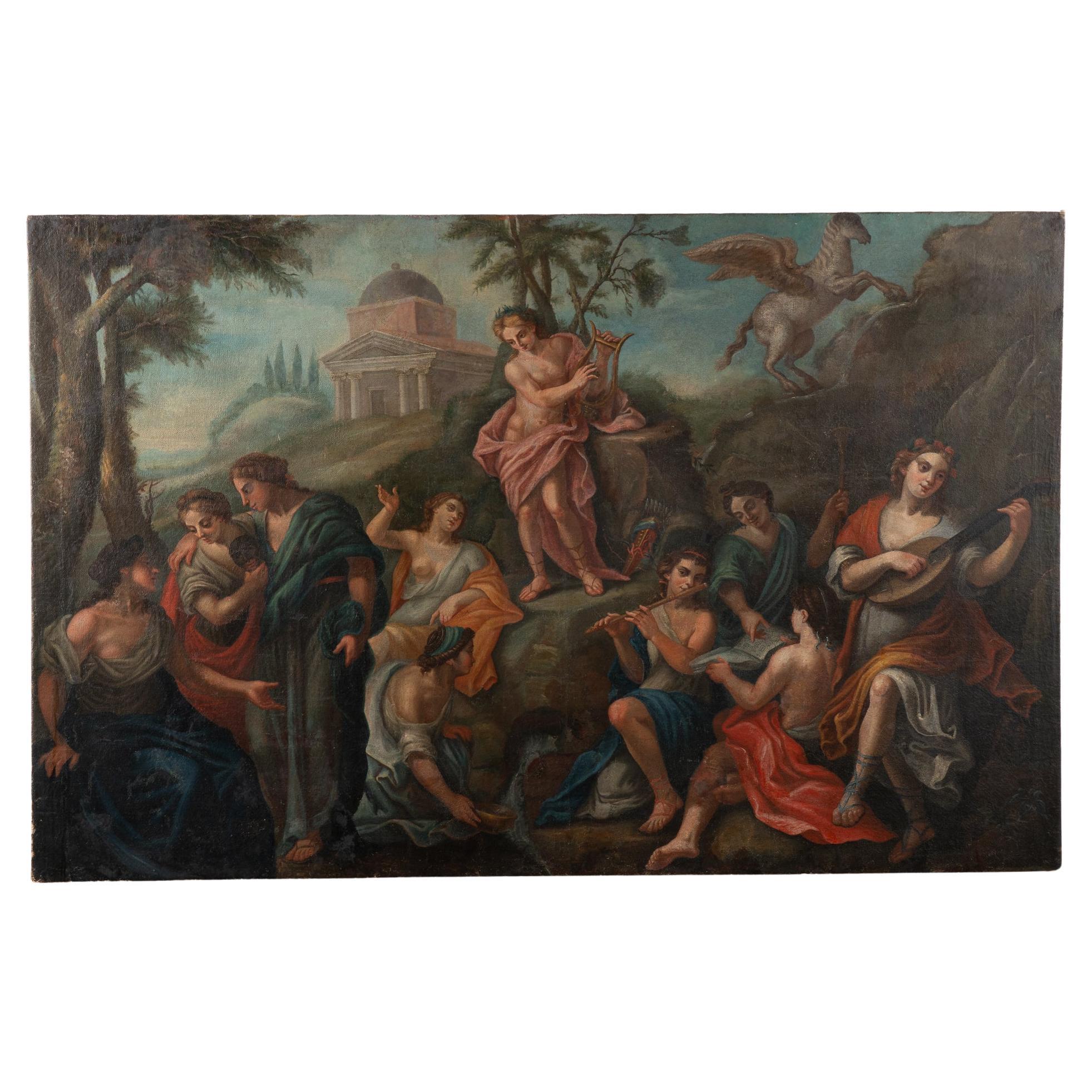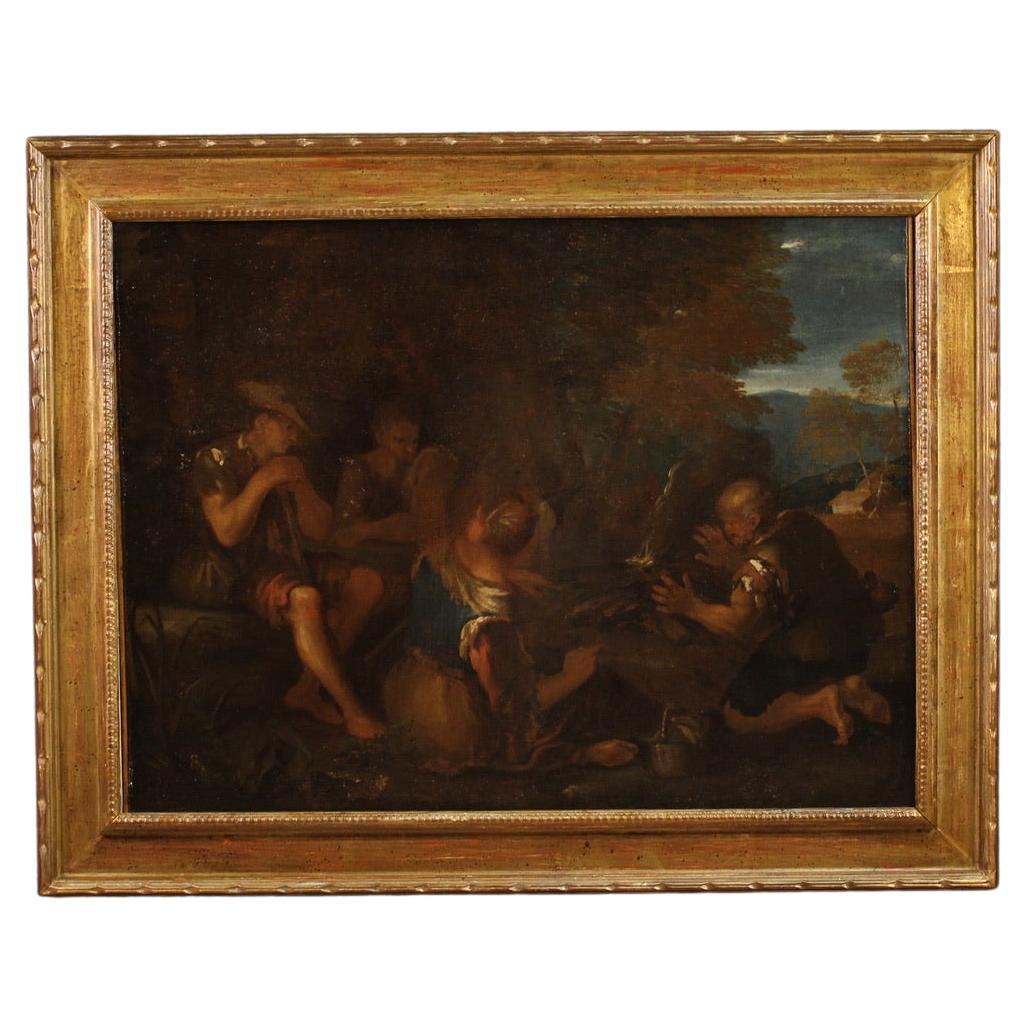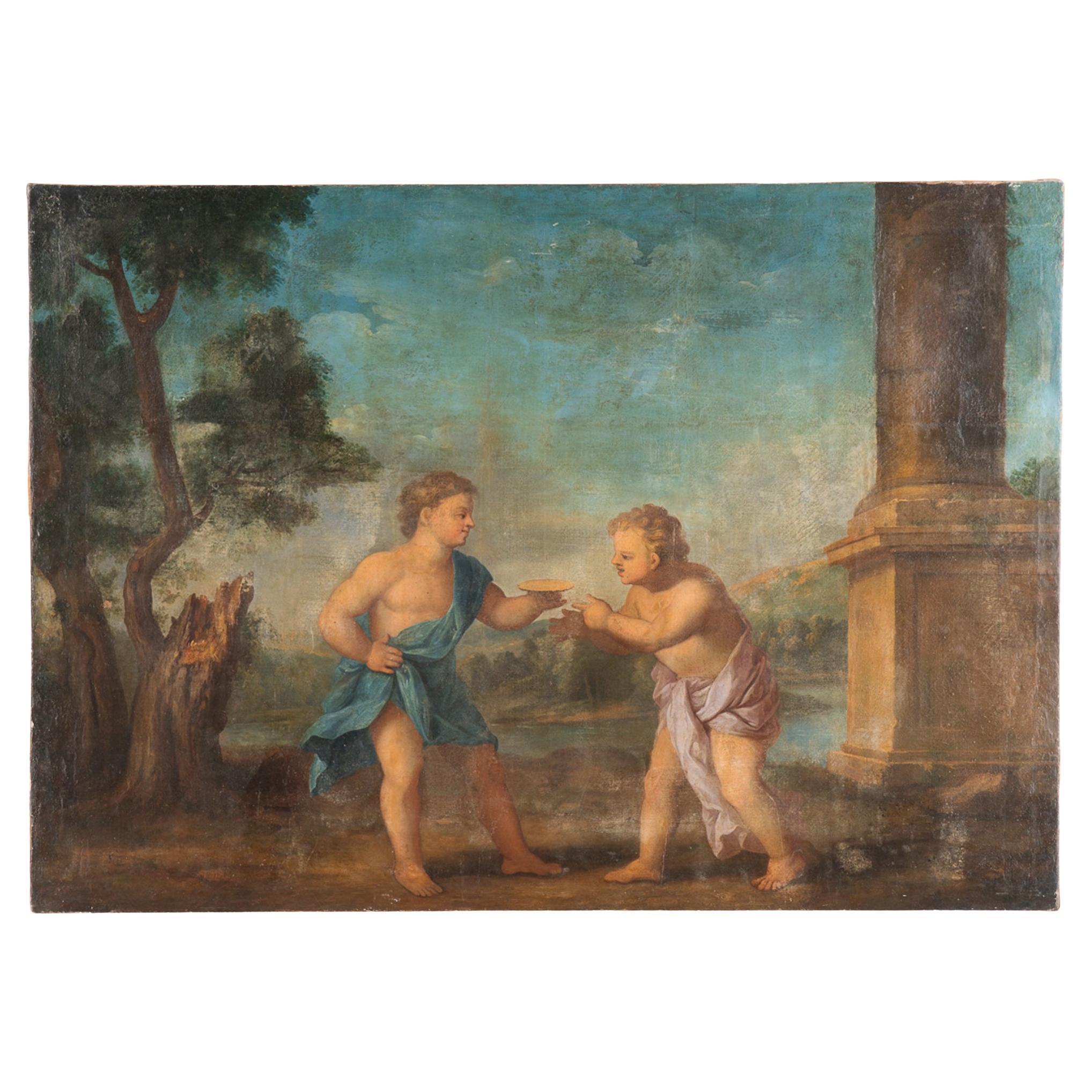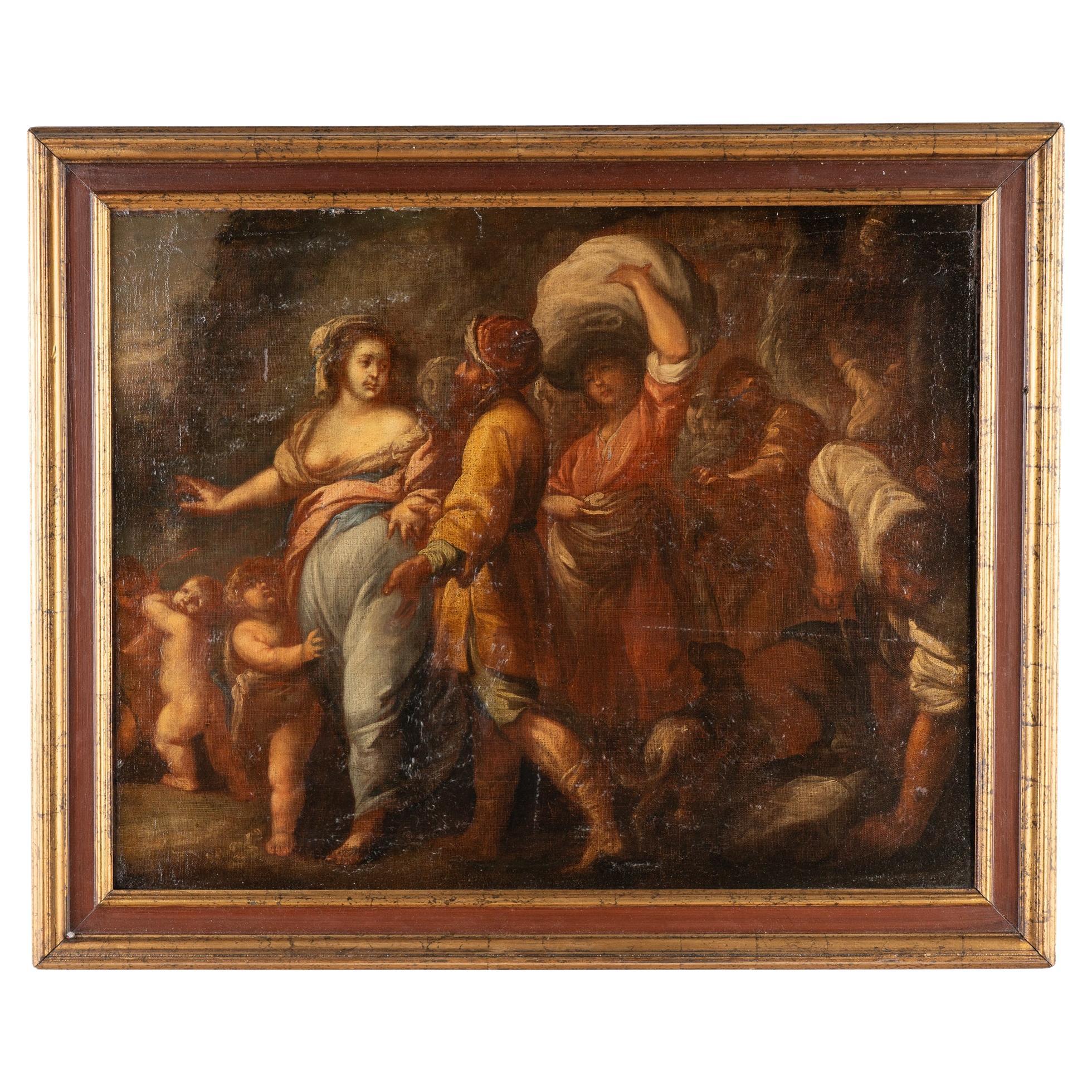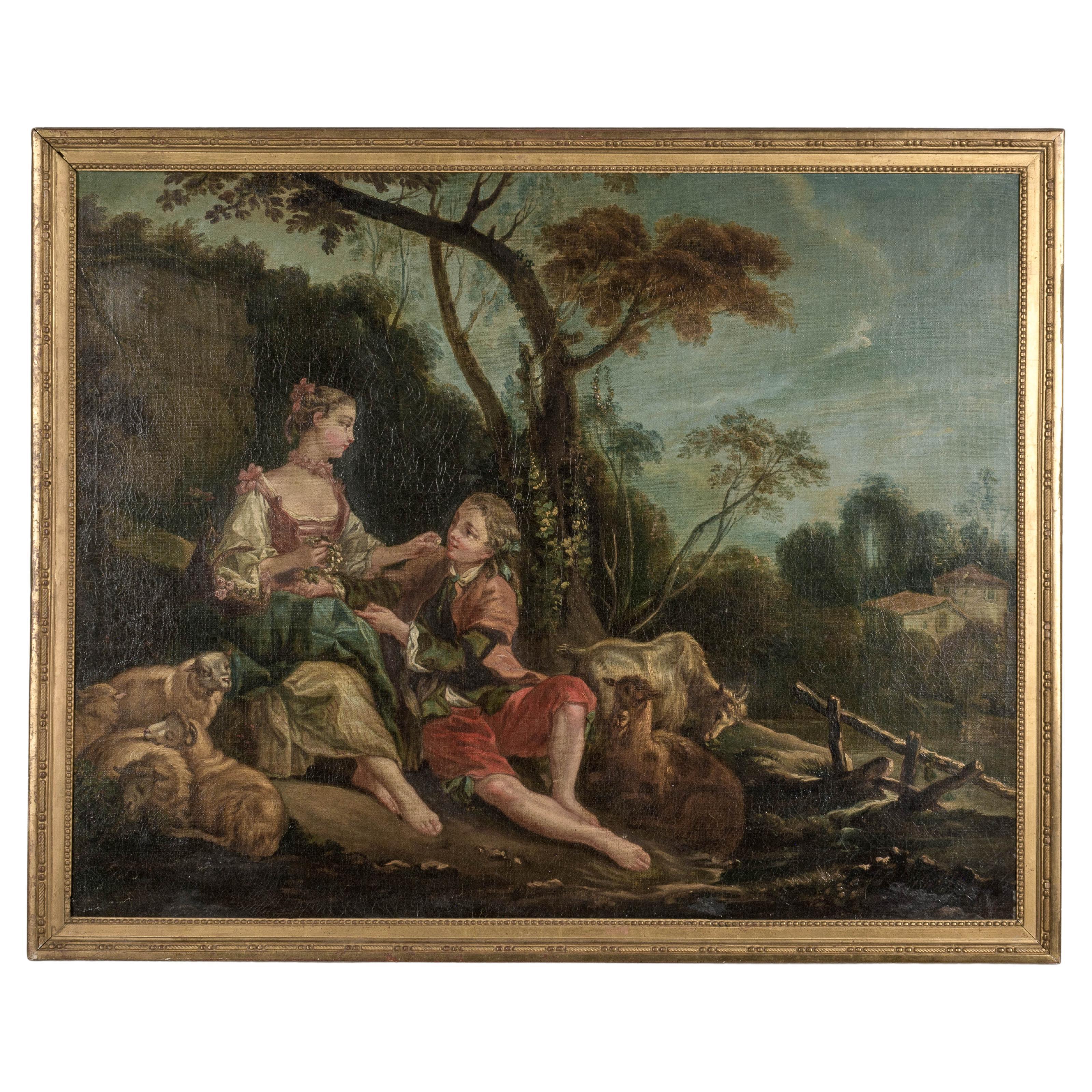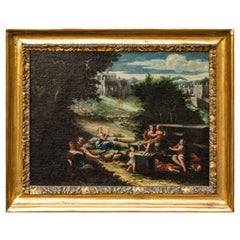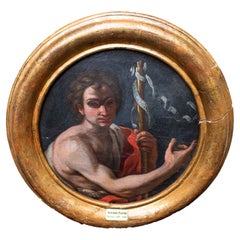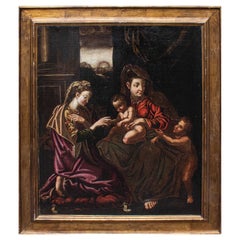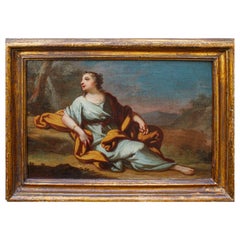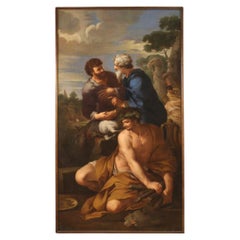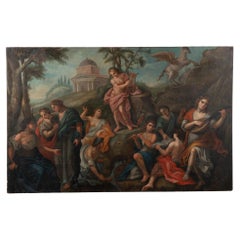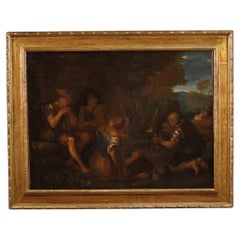Items Similar to 17th Century Angelica and Medoro Painted Oil on Canvas Roman School
Want more images or videos?
Request additional images or videos from the seller
1 of 7
17th Century Angelica and Medoro Painted Oil on Canvas Roman School
$3,662.50
£2,745.27
€3,100
CA$5,031.66
A$5,617.37
CHF 2,943.42
MX$68,762.14
NOK 37,381.44
SEK 35,245.95
DKK 23,598.33
Shipping
Retrieving quote...The 1stDibs Promise:
Authenticity Guarantee,
Money-Back Guarantee,
24-Hour Cancellation
About the Item
Roman School, 17th century
Angelica and Medoro engrave their names on the bark of a tree
Oil on canvas, 65 x 48.5 cm
The canvas depicts one of the most famous episodes of Orlando Furioso, a chivalrous poem by Ludovico Ariosto, published in Ferrara in 1519 and a source of inspiration for many artists of the following centuries. The protagonist of the nineteenth song is the beautiful Angelica, princess of Catai, of which many Christian paladins have fallen in love, including the valiant Orlando, who in the course of the poem, also meets madness, not seeing their feelings reciprocated. Yet, the charming maiden refuses all suitors, until, struck by the arrows of Love, she falls in love with Medoro, a simple Muslim soldier. Angelica, in fact, away from the battlefields, finds him wounded in the woods and stops to treat him; the more the physical wound heals, the more the wound in the heart grows. Therefore Angelica decides to get married with the Saracen in great secrecy in the forest and, overwhelmed by the love passion, the two engrave their names everywhere, before leaving permanently for India. It is precisely this universal declaration of love, which the painter of the seventeenth century intended to depict. At the edge of the forest, Angelica is intent on carving the bark of a tree, while next to her, softly stretched, is Medoro, who observes absorbed the gesture of the companion. They wear simple clothes, adapted to the bucolic atmosphere in which their love story takes place, far from the bloody war environments narrated in the previous songs by the poet from Ferrara. The painter was active in the Roman area in the seventeenth century. In the rendering of nature it seems to look at the ways of Annibale Carracci (Bologna, 1560 - Rome, 1609) and his circle; to the classicism of the time must be traced the graceful poses of the characters, which seem reminiscent of ancient sculptures, and the delicate rendering of the garments, whose colors based on red and white tones, stand out in a landscape otherwise dominated by the soft evening light.
- Dimensions:Height: 25.6 in (65 cm)Width: 18.12 in (46 cm)Depth: 1.58 in (4 cm)
- Materials and Techniques:
- Place of Origin:
- Period:
- Date of Manufacture:17th Century
- Condition:Wear consistent with age and use.
- Seller Location:Milan, IT
- Reference Number:1stDibs: LU5918233546022
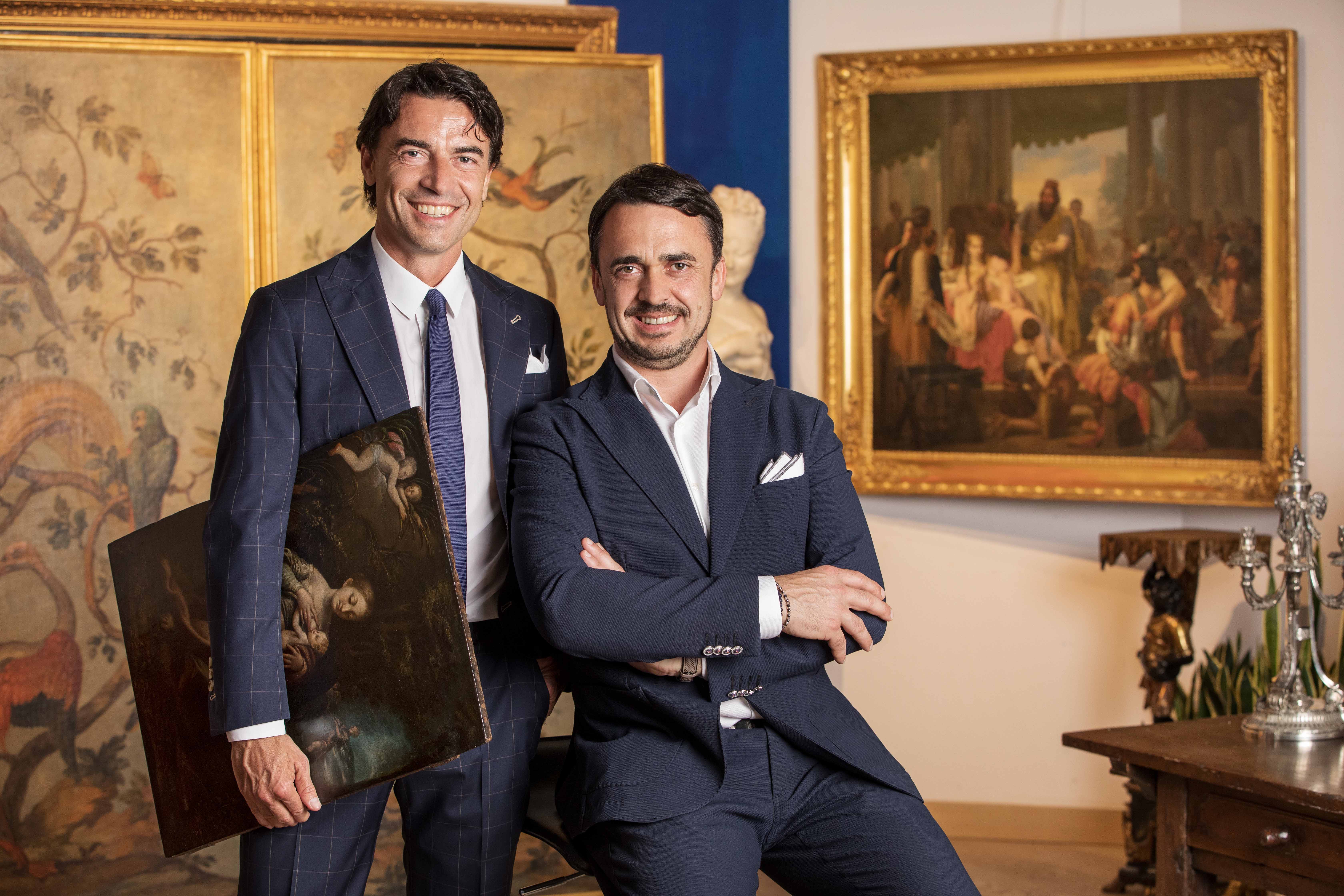
About the Seller
5.0
Vetted Professional Seller
Every seller passes strict standards for authenticity and reliability
Established in 2000
1stDibs seller since 2021
30 sales on 1stDibs
- ShippingRetrieving quote...Shipping from: Milan, Italy
- Return Policy
Authenticity Guarantee
In the unlikely event there’s an issue with an item’s authenticity, contact us within 1 year for a full refund. DetailsMoney-Back Guarantee
If your item is not as described, is damaged in transit, or does not arrive, contact us within 7 days for a full refund. Details24-Hour Cancellation
You have a 24-hour grace period in which to reconsider your purchase, with no questions asked.Vetted Professional Sellers
Our world-class sellers must adhere to strict standards for service and quality, maintaining the integrity of our listings.Price-Match Guarantee
If you find that a seller listed the same item for a lower price elsewhere, we’ll match it.Trusted Global Delivery
Our best-in-class carrier network provides specialized shipping options worldwide, including custom delivery.More From This Seller
View All17th Century Rural Landscape with Gallant Scenes Painting Oil on Canvas
Located in Milan, IT
17th century, Emilian school
Rural landscape with gallant scenes
Oil on canvas, 37 x 47.5 cm
With frame 61 x 50.5 cm
The bucolic amenity of the present is reflected in the joyful gallant scenes that dot its surface. The locus amoenus described reflects on the more traditional inflection of Arcadia, which in the literary transfiguration was the scenario par excellence of the most carefree pastoral life and out of this world; the painting is therefore a forerunner of what was professed by the actual poetic academy of Arcadia which was established in Rome in 1690, but enthusiastically testifies to the feverish invitations to its acceptance, then widespread in the most avant-garde cultural salons throughout Italy. First Theocritus and Virgil later had awakened with Idilli and Bucoliche that capacity typical of the natural world to allow an escape from reality; the contemplation of perfect natural fruits that followed would have evoked in the spirits of dreaming men back to origins. The bucolic landscape was able to positively give a rhythm to material life, and constituted the concretization of a place devoid of incivility and ugliness, where only dreams, wild music and homages to fruitful nature were allowed.
In the present painting widespread figures of shepherd children trace the same intent to the sublimation of earthly life, gathered in pairs, while children on the model of the ancient cherubs cheer the field with flowers and petals. The games of these and the sweet affections of the other characters are rendered through liquid and vibrant brushstrokes, flickering with a white light that opposes the dark shadow of the undergrowth. In the distance, the sky tapers with a silvery and flat brushstroke, while the vertical development of the promoters with architectures helps to introject a bright beam of light into the grassy clearing. The foliage and the turf of the landscape piece are rendered through a digital brushstroke, betraying the Italian brand of the present, influenced at the same time by the seventeenth-century European influences that then conveyed to the capital. The evocative culture of the city attracted many artists from the city of Bologna, from the Italian north but also from the territories beyond the Alps, such as Claude Lorrain and Nicolas Poussin. The historical-artistic heritage of the Italian pastoral scenes was thus able to fill up with the more functional and particular formalisms of the charms coming from elsewhere, such as the expressive tremor of the present, similar to the contemporary French lexicon.
The typological restitution from pastoral idyll, in accordance with the intrinsic stylistic qualities of the work, allows us to specify the solid belonging of the present to the Italian hand, similarly to what was then emerging in the pictorial sphere within the Emilian school. In this regard, we should recall the latent influences of two decisive foreign landscape painters who passed through the Emilian belt, such as Claude Lorrain (1600-1682) and Nicolas Poussin (1594-1665); before them, Giovanni Battista Viola...
Category
Antique 17th Century Italian Paintings
Materials
Canvas
17th Century St. John Baptist Florentine School Painting Oil on Canvas
Located in Milan, IT
Florentine school, 17th century
St. John Baptist
Oil on canvas, diameter cm 20 - with frame diameter 30
In this small round-format canvas, St. J...
Category
Antique 17th Century Italian Paintings
Materials
Canvas
17th Century Mystical Marriage of Saint Catherine Painting Oil on Canvas
Located in Milan, IT
17th century
Mystical marriage of Saint Catherine
Measures: Oil on canvas, 98 x 81 cm - with frame 119 x 102 cm
The scene represents the mystical marriage between Catherine of A...
Category
Antique 17th Century Italian Paintings
Materials
Canvas
18th Century Lying Female Figure Painting by Giovanni Domenico Molinari
Located in Milan, IT
Giovanni Domenico Molinari (Caresana, 1721 - Turin, 1793)
Lying Female figure
Oil on canvas, cm 46 x. 31 - With frame, cm 56 x 42
The present painting is connected by style and treated subject, in this case a young girl lying in an idyllic landscape, to the production of small pictures of pastoral subject of the Piedmontese painter Giovanni Domenico Molinari (Caresana, 1721 - Turin, 1793).
Molinare was born in Caresana (Vercelli) on 19 July 1721 but after losing both his parents he moved to Turin. Here he became, from 1736, a pupil of the Academy of Drawing founded by the painter Claudio Francesco Beaumont (Turin, 4 July 1694 - Turin, 21 June 1766) where he remained as a pensioner until December 1755. Molinari was immediately engaged in the translation of the master’s sketches on cardboard used for the Regia manufacture of tapestries. His early success on the Turin art scene is confirmed by the fact that he joined the Compagnia di San Luca in 1756.
In 1751 he married Margherita Peiroleri, whose brothers Pietro (engraver) and Nicolò (painter) also attended the school. Remained widower count two other marriages first with Lucrezia Elisabetta Burzio and then in 1770 with Domenica Maria Ferrero.
On the death of the master in 1766 Molinari, considered by his contemporaries to be the most faithful interpreter of the master and for his elegant and Arcadian style, which clearly interprets the aesthetic taste of the court, was called to finish the works that remained unfinished, such as the altarpiece for the church of Santa Maria della Scala in Moncalieri depicting the Assumption venerated by Blessed Bernard of Baden and Saint Anthony. Molinari was also well praised by critics and Abbot Lanzi highlighted the quality of the production of historical and mythological subject for the rigorous post-marattesco classicism.
In Turin he worked for Vittorio Amedeo III of Savoy as a portrait painter, executing for him eleven canvases (between 1774 and 1775), but, since 1745, he also supplied tapestry cartoons to the local Fabbrica, of which, in 1766, he became director.
The production of paintings of sacred subjects is also lively, especially used in the decoration of the churches of the capital as the Assumption for the Hotel of Virtue and San Pietro Regalado and San Benedetto il Moro for Santa Maria degli Angeli ( Torino) He also painted tempera and oil cartoons for the same church, on the occasion of the beatification of Pacifico da San Severino (1787) and, for that of San Francesco di Paola, when Gaspare de Bono...
Category
Antique 18th Century Italian Paintings
Materials
Canvas
17th Century Roman Landscape Painting Oil on Canvas by Bloemen
Located in Milan, IT
Workshop of Jan Frans van Bloemen (Antwerp, 1622 - Rome, 1749)
Lazio landscape
Oil on canvas, 48.5 x 64.5 cm
The painting, to be considered belonging to the vast production...
Category
Antique Late 17th Century Belgian Paintings
Materials
Canvas
18th Century The Sacrifice of Iphigenia Roma School Painting Oil on Canvas
Located in Milan, IT
Roman school, 18th century
The Sacrifice of Iphigenia
Oil on canvas, Measures: 50 x 64.5 cm
The canvas depicts The Sacrifice of Iphigenia, a theme reported by numerous sources, including the Greek tragedies Iphigenia in Aulis by Euripides and Agamemnon by Aeschylus, as well as in Ovid's Metamorphoses. The myth tells how the Greeks, under the command of Agamemnon, gathered at the city of Aulis, in Boeotia, from which they then set sail for Troy. The persistent calm of the winds, however, prevents the Greek ships...
Category
Antique 18th Century Italian Paintings
Materials
Canvas
You May Also Like
17th Century Oil on Canvas Italian Antique Religious Painting, 1650
Located in Vicoforte, Piedmont
Splendid 17th century Italian painting. Oil painting on canvas depicting the alliance of Jacob and Laban. The subject is inspired by a canvas by Pietro da Cortona (1596-1669), preser...
Category
Antique 1650s Italian Paintings
Materials
Canvas
$11,341 Sale Price
20% Off
Free Shipping
Original Oil On Canvas Large Allegorical Painting, Italian School 1750-1800
Located in Round Top, TX
Original large oil on canvas allegorical scene from Italy with vivid colors. Note the Pegasus, ten figures, and use of lute, lyre and flute.
Condition: Age related craquelure throug...
Category
Antique 18th Century Italian Paintings
Materials
Canvas, Wood, Paint
17th Century Oil on Canvas Venetian Style Landscape with Characters Painting
Located in Vicoforte, Piedmont
Antique Italian painting from the 17th century. Oil on canvas artwork depicting a landscape with figures from the Venetian school, of good pictorial quality. We see four characters a...
Category
Antique 1640s Italian Paintings
Materials
Canvas
Original Oil On Canvas Allegorical Scene, Italian School circa 1800
Located in Round Top, TX
The colors remain vivid in this original oil on canvas painting of allegorical scene, Italian School, circa 1800.
Condition: Age related craquelure and peelings throughout, hole (between trees), old repairs. Remains of red paper (perhaps from board?) are adhered to sections of the backside of canvas.
Canvas may benefit from light cleaning which we leave to discretion of buyer.
Please refer to professional photos for clear understanding of color, condition and details; photo lighting, individual monitor display and home lighting may all impact how item is viewed.
With over 37 years of experience selling European antiques, our brick-and-mortar storefront, Round Top Ranch Antiques...
Category
Antique 19th Century Italian Paintings
Materials
Canvas, Wood, Paint
Early 18th Century Oil on Canvas Laid on Board Painting, Italian School
Located in Round Top, TX
Original oil on canvas laid on panel painting, Italian school. Unsigned. Possibly a religious composition with three putti in lower left.
Condition: Age related craquelure, some abra...
Category
Antique Early 18th Century Italian Paintings
Materials
Canvas, Wood, Paint
18th Century French Baroque Oil Painting
Located in Winter Park, FL
A late 18th century French painting depicting a romantic couple in a pastoral setting. Oil on canvas. Unsigned. Original gilded wood frame. Small repair to canvas in the upper left c...
Category
Antique Late 18th Century French Baroque Paintings
Materials
Giltwood, Paint, Canvas
